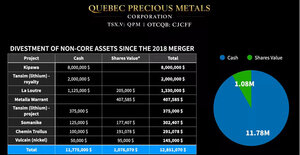Gold and Silver in Your Savings Account: James Turk on GoldMoney
Interview
Source: The Gold Report (5/23/08)
Ever wondered what GoldMoney® is, and why it might be better than storing physical metal in a bank or purchasing an ETF? James Turk, GoldMoney's founder and chairman, talks with The Gold Report about this patented gold-based electronic money that can be transferred over the Internet.
James Turk, a renowned authority on gold and the precious metal markets and co-author of "The Collapse of the Dollar," is founder and chairman of GoldMoney®, a patented gold-based electronic money, transferred over the Internet. Here he discusses how GoldMoney works, and why it's better than storing physical metal in a bank or purchasing an ETF.
TGR: Can you explain what "GoldMoney" is? And what is the difference between buying gold bullion and GoldMoney?
JT: GoldMoney is a very convenient, economic and safe way to buy gold and silver on-line and have that gold and silver stored for you in vaults in Zurich or London. A Swiss company called VIA MAT International, which is a major European secure storage and transport company, operates the vaults. And they have specialized bullion vaults where our customers’ gold is stored. Then, you can use GoldMoney as a form of payment or just let it sit there in your account as a form of savings.
There are two ways to view it: it’s like on-line banking but your account is denominated in goldgrams and mills, rather than dollars and cents. In contrast to banking, where the bank has an obligation to you, there’s no liability created by GoldMoney. You do not ‘deposit’ your gold, as you deposit money in a bank. We’re just simply storing in a secure vault gold that you own. It’s also like PayPal in the sense that you can click gold from your account to someone else’s account, if you want to use it as currency. But you do not need to use that feature and can just use GoldMoney as a savings account, but where you are saving real, sound money – gold and silver.
The key behind GoldMoney is the governance procedures that we put in place. People often ask me what three questions they should be asking before they buy gold. It’s always: "Is your gold safe?" "Is your gold safe?" "Is your gold safe?" You do not want to take risks with your bullion, which should be viewed as the bedrock asset in your portfolio. So what we have done with GoldMoney is that we’ve taken all the steps necessary to provide customers assurances of integrity that, in fact, their gold is safe. These governance procedures are disclosed on the website. One the most important of these is the regular audits by one of the Big-4 auditing firms, which establishes that the weight of gold and silver in the vault is exactly the amount recorded in customers’ accounts and that there is always this one-for-one relationship. It means that we’re actually storing gold and silver that you own. This audit report is available to our customers upon request.
And regarding your question about the difference between buying gold bullion and GoldMoney, there is no difference. When you buy gold bullion, there are two ways of doing it. You can buy gold in bars and coins and store them yourself, or you can buy them in GoldMoney and have the gold stored for you in vaults in Zurich and London. It’s just a question of diversification, convenience, and economics. Because of our economies of scale, you get more gold for your money when you’re actually buying it in GoldMoney, plus you have the opportunity to store it in countries where you don’t live. And I do recommend that geographic diversification. However, I also recommend that people consider having some gold where they live, too, because a little bit of gold on hand never hurts just in case.
I do not recommend putting your gold or silver in a bank, however, because you want to keep it some place safe. Banks are not a safe place to store gold and silver, because when gold was confiscated in 1933, the federal government went right to the banks and took all the gold and silver that was stored there.
TGR: With GoldMoney, is there a 1099?
JT: No, because we’re not a U.S. company; we operate in the British Channel Islands, and there’s no reporting outside of the British Channel Islands. In our User Agreement, we say that our user is responsible for complying with any rules or regulations from wherever he accesses GoldMoney. We have customers in over 100 different countries around the world. We couldn’t possibly comply with reporting requirements in all those different countries. So, what we do is comply with the laws in Jersey, Channel Islands, where we operate.
Jersey is a major financial center. It is located in the English Channel, so it’s located in a politically safe jurisdiction. It’s a sovereign country, and we comply with the laws of that country.
TGR: James, whether it’s an ETF or GoldMoney, this is all co-mingled. It’s not like there would be a separate account that had X amount ounces of gold and silver in my name?
JT: Well, let me first of all deal with GoldMoney, and then I will deal with the ETF. All the gold and silver stored in GoldMoney is allocated. What that means is VIA MAT has one account—the account is in the name of the customers of GoldMoney. VIA MAT doesn’t know who those customers are, but they know it is the customers of GoldMoney, and it’s allocated. There are bars with refinery serial numbers specifically allocated sitting in the VIA MAT vault, clearly distinct from other gold and silver sitting in the VIA MAT vault. And we report those bar serial numbers on the GoldMoney website, so that if you have enough gold or silver in your account to take up a whole bar, you can go to the GoldMoney website and say I want this bar with this serial number. It will be taken out of your account for free, and then VIA MAT, at your expense, will ship it to wherever you want in the world. So, all the gold and silver is allocated, and it is allocated on behalf of GoldMoney’s customers.
With ETFs, on the other hand, because of the absence of the audit, you don’t really know that it’s allocated, and I have some serious reservations about whether it is, particularly with the silver ETF. I have read the custodial agreement, and it is not an allocated bullion storage agreement; it’s a metal account. A metal account is a depository relationship that the ETF would have with the custodian. That’s very different from an allocated bullion storage account agreement. So I have some serious reservations as to whether the silver in the SLV ETF is allocated or not.
There’s a lot of uncertainty about storage when you’re involved in storing metal, as I discussed earlier in regard to the banks, and there’s still a lot of uncertainly with ETFs whether the gold and silver really are there. But even if they are there, you don’t own gold or silver with an ETF. You own shares in a fund that supposedly owns the gold and silver. That’s different from owning the gold and silver yourself. With GoldMoney, you own the gold and silver; you have access to it 24/7 through your account on-line, and you can have that gold and silver sent to you, if you want, if you have enough gold and silver in your account to take delivery of a bar. Or you can use that gold and silver and go to KITCO and buy small bars or coins with it if you want to have something in hand. But you cannot do that with an ETF.
TGR: Can you give me a rough idea of the number of public companies—gold companies—that use GoldMoney? Do you have a sense of that?
JT: Not a lot, and there’s a specific reason for that. Our operating system isn’t really very friendly from a company point of view, and this is actually something we’re working on over the balance of this year and next year. For example, companies want access with dual passwords, and we do not have that capability. We have been operating for seven years, and we have focused primarily on the retail market rather than the corporate market. The reason is that the retail market opportunities made more sense in trying to build GoldMoney from scratch the way we have. We’re now storing about $350 million dollars in gold, silver, and recently we have added currency too, because people can put money into segregated funds accounts at our banks in Jersey and earn interest on their money until they’re ready to buy gold and silver.
What we are going to do later this year and next year is what I call corporate enhancements. What this means is we’re going to make GoldMoney more friendly to corporate chief financial officers. It will be more bank-like in that we will have A & B signatures, and dual passwords and those types of things that will make it easier for a corporation to fit it into their treasury function. Once we have done this additional software development, we will then be talking to gold mining companies about using GoldMoney as a way of paying suppliers, i.e. paying their contractors in gold, rather than by going the expensive way by paying with bank wire transfers.
Recently one of our customers wrote to me and said they had done a wire transfer that ended up costing $55 to do the transaction, which is pretty outrageous. In GoldMoney you can click gold from your account to someone else’s account, and a maximum it will cost you is $2.50 at current exchange rates. And it’s efficient; you can make a goldgram payment 24/7, and payments are completed outside the banking system.
So, the idea is once we have these corporate enhancements in place, we’re going to begin actively marketing GoldMoney among the mining companies, and then eventually among the natural resource companies of all sorts.
TGR: Well, James, this is all interesting to say the least, and this has been very insightful, and I appreciate your giving us the time this afternoon.
JT: Thank you, and if your readers would like more information, I suggest they visit GoldMoney.com.
TGR: Can you explain what "GoldMoney" is? And what is the difference between buying gold bullion and GoldMoney?
JT: GoldMoney is a very convenient, economic and safe way to buy gold and silver on-line and have that gold and silver stored for you in vaults in Zurich or London. A Swiss company called VIA MAT International, which is a major European secure storage and transport company, operates the vaults. And they have specialized bullion vaults where our customers’ gold is stored. Then, you can use GoldMoney as a form of payment or just let it sit there in your account as a form of savings.
There are two ways to view it: it’s like on-line banking but your account is denominated in goldgrams and mills, rather than dollars and cents. In contrast to banking, where the bank has an obligation to you, there’s no liability created by GoldMoney. You do not ‘deposit’ your gold, as you deposit money in a bank. We’re just simply storing in a secure vault gold that you own. It’s also like PayPal in the sense that you can click gold from your account to someone else’s account, if you want to use it as currency. But you do not need to use that feature and can just use GoldMoney as a savings account, but where you are saving real, sound money – gold and silver.
The key behind GoldMoney is the governance procedures that we put in place. People often ask me what three questions they should be asking before they buy gold. It’s always: "Is your gold safe?" "Is your gold safe?" "Is your gold safe?" You do not want to take risks with your bullion, which should be viewed as the bedrock asset in your portfolio. So what we have done with GoldMoney is that we’ve taken all the steps necessary to provide customers assurances of integrity that, in fact, their gold is safe. These governance procedures are disclosed on the website. One the most important of these is the regular audits by one of the Big-4 auditing firms, which establishes that the weight of gold and silver in the vault is exactly the amount recorded in customers’ accounts and that there is always this one-for-one relationship. It means that we’re actually storing gold and silver that you own. This audit report is available to our customers upon request.
And regarding your question about the difference between buying gold bullion and GoldMoney, there is no difference. When you buy gold bullion, there are two ways of doing it. You can buy gold in bars and coins and store them yourself, or you can buy them in GoldMoney and have the gold stored for you in vaults in Zurich and London. It’s just a question of diversification, convenience, and economics. Because of our economies of scale, you get more gold for your money when you’re actually buying it in GoldMoney, plus you have the opportunity to store it in countries where you don’t live. And I do recommend that geographic diversification. However, I also recommend that people consider having some gold where they live, too, because a little bit of gold on hand never hurts just in case.
I do not recommend putting your gold or silver in a bank, however, because you want to keep it some place safe. Banks are not a safe place to store gold and silver, because when gold was confiscated in 1933, the federal government went right to the banks and took all the gold and silver that was stored there.
TGR: With GoldMoney, is there a 1099?
JT: No, because we’re not a U.S. company; we operate in the British Channel Islands, and there’s no reporting outside of the British Channel Islands. In our User Agreement, we say that our user is responsible for complying with any rules or regulations from wherever he accesses GoldMoney. We have customers in over 100 different countries around the world. We couldn’t possibly comply with reporting requirements in all those different countries. So, what we do is comply with the laws in Jersey, Channel Islands, where we operate.
Jersey is a major financial center. It is located in the English Channel, so it’s located in a politically safe jurisdiction. It’s a sovereign country, and we comply with the laws of that country.
TGR: James, whether it’s an ETF or GoldMoney, this is all co-mingled. It’s not like there would be a separate account that had X amount ounces of gold and silver in my name?
JT: Well, let me first of all deal with GoldMoney, and then I will deal with the ETF. All the gold and silver stored in GoldMoney is allocated. What that means is VIA MAT has one account—the account is in the name of the customers of GoldMoney. VIA MAT doesn’t know who those customers are, but they know it is the customers of GoldMoney, and it’s allocated. There are bars with refinery serial numbers specifically allocated sitting in the VIA MAT vault, clearly distinct from other gold and silver sitting in the VIA MAT vault. And we report those bar serial numbers on the GoldMoney website, so that if you have enough gold or silver in your account to take up a whole bar, you can go to the GoldMoney website and say I want this bar with this serial number. It will be taken out of your account for free, and then VIA MAT, at your expense, will ship it to wherever you want in the world. So, all the gold and silver is allocated, and it is allocated on behalf of GoldMoney’s customers.
With ETFs, on the other hand, because of the absence of the audit, you don’t really know that it’s allocated, and I have some serious reservations about whether it is, particularly with the silver ETF. I have read the custodial agreement, and it is not an allocated bullion storage agreement; it’s a metal account. A metal account is a depository relationship that the ETF would have with the custodian. That’s very different from an allocated bullion storage account agreement. So I have some serious reservations as to whether the silver in the SLV ETF is allocated or not.
There’s a lot of uncertainty about storage when you’re involved in storing metal, as I discussed earlier in regard to the banks, and there’s still a lot of uncertainly with ETFs whether the gold and silver really are there. But even if they are there, you don’t own gold or silver with an ETF. You own shares in a fund that supposedly owns the gold and silver. That’s different from owning the gold and silver yourself. With GoldMoney, you own the gold and silver; you have access to it 24/7 through your account on-line, and you can have that gold and silver sent to you, if you want, if you have enough gold and silver in your account to take delivery of a bar. Or you can use that gold and silver and go to KITCO and buy small bars or coins with it if you want to have something in hand. But you cannot do that with an ETF.
TGR: Can you give me a rough idea of the number of public companies—gold companies—that use GoldMoney? Do you have a sense of that?
JT: Not a lot, and there’s a specific reason for that. Our operating system isn’t really very friendly from a company point of view, and this is actually something we’re working on over the balance of this year and next year. For example, companies want access with dual passwords, and we do not have that capability. We have been operating for seven years, and we have focused primarily on the retail market rather than the corporate market. The reason is that the retail market opportunities made more sense in trying to build GoldMoney from scratch the way we have. We’re now storing about $350 million dollars in gold, silver, and recently we have added currency too, because people can put money into segregated funds accounts at our banks in Jersey and earn interest on their money until they’re ready to buy gold and silver.
What we are going to do later this year and next year is what I call corporate enhancements. What this means is we’re going to make GoldMoney more friendly to corporate chief financial officers. It will be more bank-like in that we will have A & B signatures, and dual passwords and those types of things that will make it easier for a corporation to fit it into their treasury function. Once we have done this additional software development, we will then be talking to gold mining companies about using GoldMoney as a way of paying suppliers, i.e. paying their contractors in gold, rather than by going the expensive way by paying with bank wire transfers.
Recently one of our customers wrote to me and said they had done a wire transfer that ended up costing $55 to do the transaction, which is pretty outrageous. In GoldMoney you can click gold from your account to someone else’s account, and a maximum it will cost you is $2.50 at current exchange rates. And it’s efficient; you can make a goldgram payment 24/7, and payments are completed outside the banking system.
So, the idea is once we have these corporate enhancements in place, we’re going to begin actively marketing GoldMoney among the mining companies, and then eventually among the natural resource companies of all sorts.
TGR: Well, James, this is all interesting to say the least, and this has been very insightful, and I appreciate your giving us the time this afternoon.
JT: Thank you, and if your readers would like more information, I suggest they visit GoldMoney.com.



































